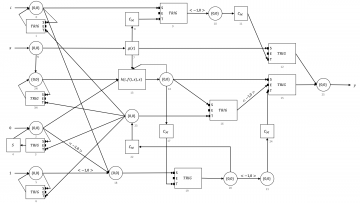
Achievement
ORNL researchers proved that neuromorphic computing is Turing-complete. This is a fundamental result in the field and theoretically underpins what neuromorphic computing is capable of doing.
Significance and Impact
Neuromorphic computing has primarily been used in spiking neural network-based machine learning applications such as computer vision and control problems. As such, the application space of neuromorphic computing has been fairly limited. Proving that neuromorphic computing is Turing-complete opens the door for a plethora of applications. It essentially proves that neuromorphic computing is capable of doing everything that today's computers can do. Given the fact that neuromorphic computers consume orders of magnitude less power as compared to CPUs and GPUs, it might potentially be possible to replace CPUs and GPUs with neuromorphic processors and save orders of magnitude of energy. This is a critical result for energy-efficient computing in the future.
Research Details
A model of neuromorphic computing with two neuron parameters (threshold and leak) and two synaptic parameters (weight and delay) was proposed. It is possible to realize this model of neuromorphic computing on most neuromorphic hardware today. It was then shown that this model of neuromorphic computing is Turing-complete by devising neuromorphic circuits for all the mu-recursive functions and operators. Given that the set of mu-recursive functions and operators is precisely what a Turing-machine can execute, this work establishes tha Turing-completeness of neuromorphic computing.
Overview
Neuromorphic computing is a non-von Neumann computing paradigm that performs computation by emulating the human brain. Neuromorphic systems are extremely energy-efficient and known to consume thousands of times less power than CPUs and GPUs. They have the potential to drive critical use cases such as autonomous vehicles, edge computing and internet of things in the future. For this reason, they are sought to be an indispensable part of the future computing landscape. Neuromorphic systems are mainly used for spike-based machine learning applications, although there are some non-machine learning applications in graph theory, differential equations, and spike-based simulations. These applications suggest that neuromorphic computing might be capable of general-purpose computing. However, general-purpose computability of neuromorphic computing has not been established yet. In this work, we prove that neuromorphic computing is Turing-complete and therefore capable of general-purpose computing. Specifically, we present a model of neuromorphic computing, with just two neuron parameters (threshold and leak), and two synaptic parameters (weight and delay). We devise neuromorphic circuits for computing all the mu-recursive functions (i.e., constant, successor and projection functions) and all the mu-recursive operators (i.e., composition, primitive recursion and minimization operators). Given that the mu-recursive functions and operators are precisely the ones that can be computed using a Turing machine, this work establishes the Turing-completeness of neuromorphic computing.
Last Updated: August 31, 2022 - 1:11 pm